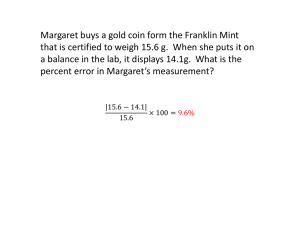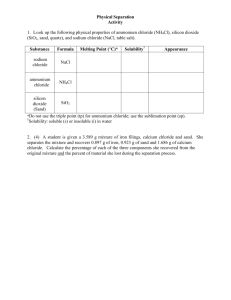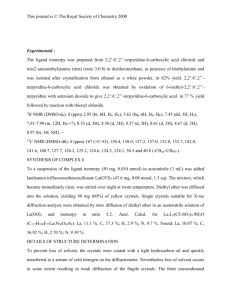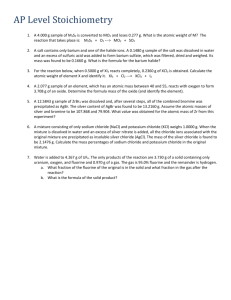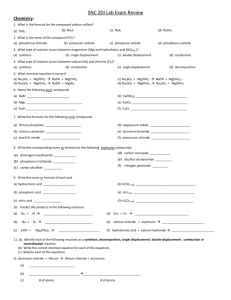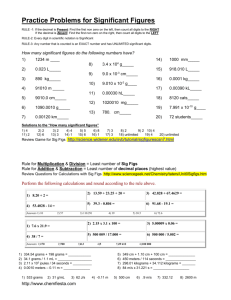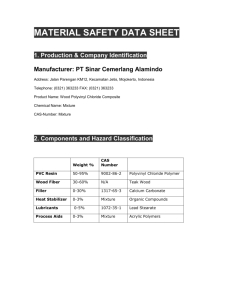Final Exam Review 1 Key
advertisement
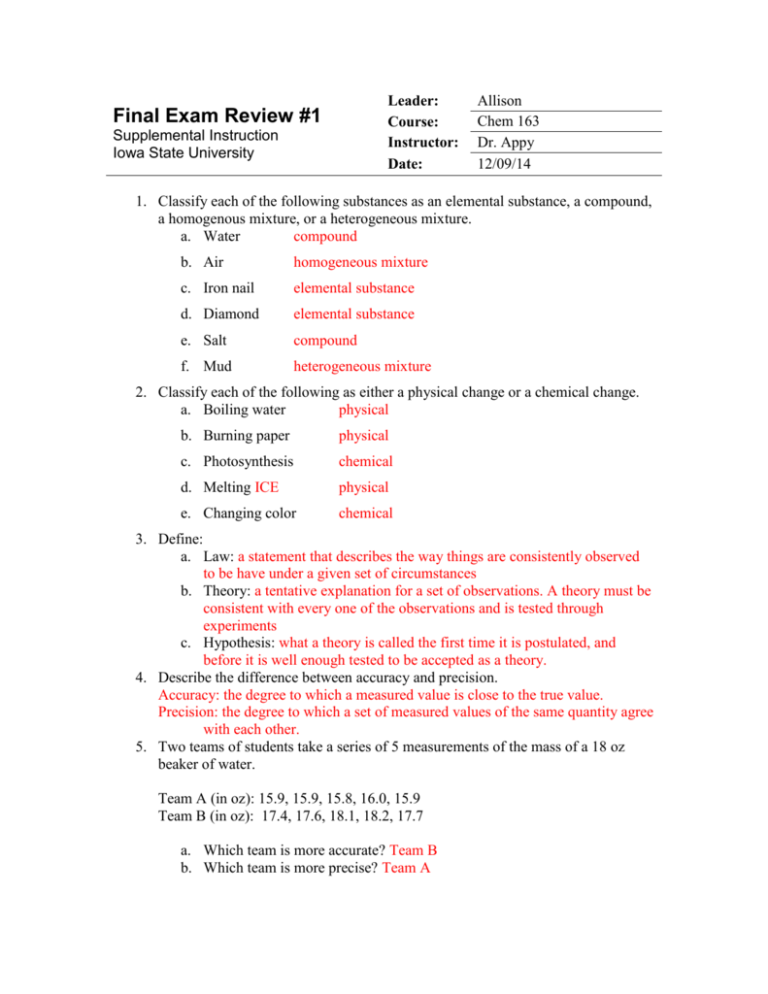
Leader: Course: Instructor: Date: Final Exam Review #1 Supplemental Instruction Iowa State University Allison Chem 163 Dr. Appy 12/09/14 1. Classify each of the following substances as an elemental substance, a compound, a homogenous mixture, or a heterogeneous mixture. a. Water compound b. Air homogeneous mixture c. Iron nail elemental substance d. Diamond elemental substance e. Salt compound f. Mud heterogeneous mixture 2. Classify each of the following as either a physical change or a chemical change. a. Boiling water physical b. Burning paper physical c. Photosynthesis chemical d. Melting ICE physical e. Changing color chemical 3. Define: a. Law: a statement that describes the way things are consistently observed to be have under a given set of circumstances b. Theory: a tentative explanation for a set of observations. A theory must be consistent with every one of the observations and is tested through experiments c. Hypothesis: what a theory is called the first time it is postulated, and before it is well enough tested to be accepted as a theory. 4. Describe the difference between accuracy and precision. Accuracy: the degree to which a measured value is close to the true value. Precision: the degree to which a set of measured values of the same quantity agree with each other. 5. Two teams of students take a series of 5 measurements of the mass of a 18 oz beaker of water. Team A (in oz): 15.9, 15.9, 15.8, 16.0, 15.9 Team B (in oz): 17.4, 17.6, 18.1, 18.2, 17.7 a. Which team is more accurate? Team B b. Which team is more precise? Team A 6. Determine how many significant figures are in the following: a. 0.0987 ----- 3 sig figs b. 100,030 ----- 5 sig figs c. 0.000975 ----- 3 sig figs d. 9.00 ----- 3 sig figs 7. Carry out the following operations. Express the answers with the appropriate number of significant figures. a. (5.678 – 1.56) x 0.00987 = 0.0406 b. 4.67 + 0.98 = 5.65 c. 3.4567 x 2300 = 8.0 x 10^3 8. The speed of light is 3.00 x 108 m/s. Express the speed of light in mi/hr. 9. Express each of the following measured quantities in either standard notation of scientific notation (whichever form it is not already in). a. 1.234 x 104 m --- 12,340 m b. 1.900 x 103 m ---- 1900 c. 0.00078 cm ---- 7.8 x 10^-4 d. 0.00000009 ft ----- 9 x 10^-8 10. Express absolute zero in both Celsius and Fahrenheit to the nearest degree. K = ºC + 273.15 ºF = 32 + (9/5)ºC ºC = K – 273.15 ºF = 32 + (9/5)(-273.15) ºC = 0 – 273.15 ºF = 32 - 491.67 = -273.15 ºC -273 ºC = -459.67 ºF -460. ºF or -4.60 x 102 ºF 11. What volume, in mL, is occupied by 8.87 grams of solid gold (density = 19.3 g/ml) at 25.0 degrees Celsius? d= m/v v= m/d 8.87 g / (19.3 g/mL) = 0.460 mL 12. How much energy (in J) is required to heat 1.89 x 105 g of water from 25.7 ºC to 67.8ºC? ΔT = 67.8 – 25.7 = 42.1 ºC q= mCsΔT = (1.89 x 105 g)(4.184J/gºC)(42.1ºC) = 3.33 x 10^7 13. Write the correct charge for each subatomic particles: a. Protons + b. Neutrons No Charge c. Electrons - 14. Fill in the table: Protons Neutrons Electrons Net Charge 19 21 18 +1 Fe 26 30 26 0 Na+ 11 12 10 +1 31 15 16 15 0 40 K+ 56 23 P 15. Which of the following is not part of Dalton’s atomic theory? a. All matter is made up of atoms. b. Atoms can be neither created nor destroyed. c. Atoms of a particular element are alike. d. Atoms of different elements differ. e. Most of the mass of an atom is contained in the nucleus f. Chemical reactions involve the union or separation of atoms 16. List the following elements in order of increasing first ionization energy (from lowest to highest): Ne, O, Mg, Ca, K, P K, Ca, Mg, P, O, Ne 17. What color of light is emitted by a hydrogen atom who’s electron transfers from n=3 to the n=1 energy state? Use the energy level diagram and visible spectrum. n=3 n=1 12.1 eV 1.0 eV 11.1 eV E= hc/wavelength wavelength = hc/E = (6.626 x 10^ -34 J*s)(3.00x10^8 m/s) 11.1 eV ___(1 ev)__ ___(10^9 nm)___ (1.602x10^-19 J) 1m = 102.5 nm --- Ultraviolet 18. Write the full AND abbreviated electron configurations for a silver atom in the ground state. 1s2, 2s2, 2p6, 3s2, 3p6, 4s2, 3d10, 4p6, 5s2, 4d9 [Kr]5s2, 4d9 19. Predict which of the follow ionic compounds will have the highest melting point. NaCl, CaCl2, MgS 20. Place the following atoms in order of increasing atomic size (smallest to largest). Cl, Ne, Na, Rb Ne, Cl, Na, Rb 21. Define electronegativity. 22. Name the following compounds: a. LiCl Lithium chloride b. MgCl2 Magnesium chloride c. SF6 Sulfur hexafluoride d. N2O4 Dinitrogen tetroxide e. NaNO2 Sodium nitrite f. HF Hydrofluoric acid g. H2S Hydrosulfuric acid h. CoCl2 Cobalt (II) chloride or Cobaltous chloride i. HNO3 Nitric acid j. CuCl Copper (I) Chloride or Cuprous chloride 23. Fill out the following chart: Compound H2O SO2 Electronic Geometry Molecular Geometry Bond Angle Tetrahedral Bent <109.5 Trigonal planar Bent <120 AsF3 Trigonal Tetrahedral <109.5 pyramidal CF4 Tetrahedral Tetrahedral 109.5 For Hydrogen: Useful Equations and Conversions: E = hc/λ c = 3.00 x 108 m/s h = 6.626 x 10-34 J*s 1 eV = 1.602 x 10-19 J 1 m = 109 nm F = kq1q2/r2


